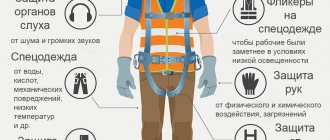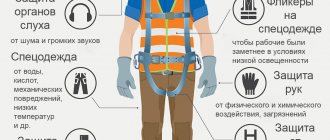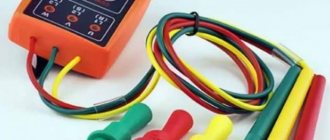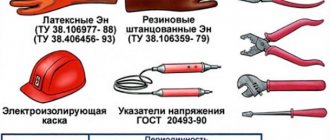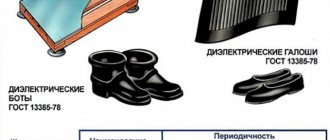Normative base
Order of the Ministry of Labor of Russia dated July 24, 2013 N 328n “On approval of the Rules for labor protection during the operation of electrical installations”
Order of the Ministry of Energy of Russia dated January 13, 2003 N 6 “On approval of the Rules for the technical operation of consumer electrical installations”
Order of the Ministry of Energy of Russia dated June 30, 2003 N 261 “On approval of the Instructions for the use and testing of protective equipment used in electrical installations”
Condition monitoring and accounting
All electrical protective devices and mounting belts in use must be numbered (exceptions include stands, mats, and safety signs). Numbering is carried out at the substation or electrical network separately for all types of electrical protective equipment. If the device has several elements, then the number must be indicated on all parts.
At the substation, in the workshops of the power plant, in laboratories, it is necessary to keep books of contents and records, which indicate numbers, names, dates of regular tests and inspections, and location. Devices that are used individually are also described in the book, marked with the date and time of issue, as well as the signature of the employee who received them.
During operation, protective equipment must be subjected to periodic acceptance tests. The test results must be recorded in the book of the laboratory that performed them. The pattern of maintaining a ledger is not regulated.
After testing, a special stamp is installed on all products. It must be clearly visible. The stamp is either applied with paint, or knocked out, or glued to the insulating area. If the device has several elements, then the stamp is installed on only one part. On electrical protection equipment that was found to be faulty during testing, the stamp is crossed out with red paint.
Sad statistics
According to statistics, up to 30,000 people die from electric shock every year. Most often, the causes of electrical injuries are ignorance of the mechanism of physiological effects of electric current on the human body, violation of current rules and instructions on occupational safety and non-use of personal protective equipment.
The consequences of possible injury from direct electric current can be different - from quite mild to very sad, for example:
- convulsive muscle contraction without loss of consciousness;
- convulsive muscle contraction with loss of consciousness, but with preserved breathing and heart function;
- loss of consciousness and disturbances in cardiac activity or breathing (or both);
- clinical death, that is, lack of breathing and blood circulation.
The following components influence the outcome of an electric shock:
- the duration of passage of electric current through the human body;
- frequency and type of current;
- physiological characteristics of a person;
- resistance to stress;
- voltage value.
Every employer must make every effort to eliminate the causes of electrical injuries at the enterprise. First of all, this is facilitated by the training of personnel servicing electrical installations and the use of the necessary PPE. By the way, the employer must provide personal protective equipment to employees completely free of charge when working in electrical installations.
Additional devices
Auxiliary devices complement the main equipment, and are also required for protection against touch voltage and cannot independently protect against electric shock. For electrical installations over 1000 volts the following are used:
- shielding kits;
- dielectric mats, mittens, galoshes, caps;
- portable grounding;
- insulating pads;
- safety signs;
- Walling.
Auxiliary devices in installations up to 1000 volts include portable grounding, dielectric mats and galoshes, safety signs, fencing structures, insulating gaskets.
What you need to know
Of course, the best protection against electric shock is a “head on your shoulders.” To protect yourself from electrical injuries, you need to know:
- “Rules on labor protection during the operation of electrical installations”, approved. By Order of the Ministry of Labor of the Russian Federation dated July 24, 2013 No. 328n (as amended on February 19, 2016);
- "PTEEP", approved. By Order of the Ministry of Energy of the Russian Federation dated January 13, 2003 No. 6;
- “Rules for electrical installations”, approved. Order of the Ministry of Energy of the Russian Federation dated May 20, 2003 No. 187 (as amended on December 20, 2017) and other regulations relating to this area.
Next, we will talk in detail about the personal protective equipment that every electrician should use in their work.
Frequency of inspections and tests
In accordance with current standards and rules, a clear frequency of testing and inspection has been defined for PPE used in work. Mandatory regularity of operational tests:
- Every six months, dielectric gloves are subjected to such a check.
- Every year it is necessary to test insulated hand tools, protective overshoes, measuring rods, including high-voltage voltage regulators.
- Every 2 years, current and insulating clamps and operating rods are checked.
- Dielectric boots must be tested at least once a year.
What types of personal protective equipment are there (electrical safety)
PPE intended to protect a person from the effects of current is usually made partially or completely from materials that do not conduct it (rubber, porcelain, wood with special impregnation). There are collective and individual means of protection in electrical installations.
Collective ones include:
- safety barriers;
- grounding, grounding and disconnection of electrical equipment housings that may be energized;
- use of safe voltage 12-36 V;
- warning posters (they are usually hung near dangerous places);
- automatic air circuit breakers.
Personal protective equipment against electric current is divided into basic and additional.
Basic - these personal protective equipment in electrical installations withstand direct contact with live objects for a long time. Therefore, they are used when carrying out electrical installation work without de-energizing electrical devices from the network.
Also, depending on the voltage in the network, there are two types of conditions in which electrician personal protective equipment is used: up to 1000 V and over 1000 V. The same classification applies to additional equipment.
Basic personal protective equipment for electricians up to 1000 V:
- dielectric gloves;
- insulating rods;
- insulating and electrical clamps;
- plumbing and assembly tools with insulating handles;
- voltage indicators.
In electrical installations over 1000 V:
- insulating rods;
- insulating and electrical clamps;
- voltage indicators;
- means for repair work under voltage above 1000 V.
Additional - this protection is not able to fully protect a person from the effects of electric current, and therefore such PPE is used in conjunction with the main ones. Let us consider this type of funds in more detail and list what applies to them.
In electrical installations up to 1000 V:
- dielectric galoshes;
- dielectric carpets;
- insulating stands.
In electrical installations over 1000 V:
- dielectric gloves;
- dielectric boots;
- dielectric carpets;
- insulating stands;
- dielectric gaskets and caps.
We will give a list of personal protective equipment for electricians, most often used in electrical installation work.
Dielectric gloves
Protect human hands from touching devices and parts that are under electrical voltage. Most often they are made from sheet rubber and have a universal size. Gloves marked “Ev” are additional PPE when working with electrical voltages over 1000 Volts.
And the “En” marking means that the gloves are capable of protecting a worker from exposure to electric current of up to 1000 Volts. In this case, this type of PPE is the main one.
Only dry gloves that have passed a leak test are allowed for use.
Insulating pliers
Insulating pliers are PPE when working in electrical installations up to and above 1000 V, as well as for:
- installation and removal of fuses;
- removing insulating linings;
- removal of fence panels and other similar work in electrical installations up to 35 kV inclusive.
They consist of a working part (plier jaws), an insulating part and a handle. When working with them, you should additionally use dielectric gloves and PPE to protect your eyes and face.
Voltage indicators
Before starting installation or repair work on power plants and wires, it is necessary to monitor the network indicators, check the absence of current or its parameters. For this purpose, a voltage indicator is used, which can determine the presence of voltage and its coincidence up to 1000 V.
The most commonly used devices are voltages up to 1000 Volts. Such an indicator can be double-pole or single-pole. Bipolar ones are more accurate, which is why they are called high-voltage and are used during complex work.
Dielectric mats
Such dielectric personal protective equipment is a mat under the feet that does not conduct electric current. Mats are placed in front of electrical panels and high voltage cabinets.
Most often they are made of rubber with a special layer. Additionally, a corrugated pattern with a depth of 3-5 millimeters is made on the surface of the litter, which reduces the contact area and increases the resistance to current flow along the surface of the product. The maximum voltage withstandable by the dielectric mat is indicated by the manufacturer on the label.
Dielectric stairs
When carrying out repair work, it often becomes necessary to perform actions at a certain height. The use of a conventional metal ladder (for example, aluminum) creates a high risk of electric shock to the worker. Therefore, in such cases, you should use special dielectric ladders. They are made of lightweight but durable fiberglass and are therefore safe.
Protective clothing
Basic protection against electric shock
To ensure that personnel are reliably protected from the thermal effects of an electric arc, a set of special clothing is selected:
- it includes a suit made of heat-resistant material with high protective properties;
- be sure to wear underwear made of heat-resistant fiber or 100% cotton;
- foot protection shoes made of special leather with heat-resistant soles; all seams must be made of threads resistant to high temperatures; there are no metal parts on the boots;
- Additionally, raincoats and winter suits (also heat-resistant) are provided.
Costume
The suit itself consists of trousers and a jacket or overalls. Fire resistance is provided by special impregnations that do not lose their properties even after washing.
Note! Protective clothing helps reduce the impact of arc energy and protect the body from severe overheating.
Advantages:
- does not ignite or melt;
- maintains heat resistance for the entire declared period of operation;
- resists mechanical stress well.
Suits used as personal protective equipment will protect the body from the flow of electricity. energy of any power.
Heat Resistant Protective Clothing
For each specific enterprise, clothing with thermal protection is selected based on the degree of risk and the working conditions of the personnel. All kits undergo mandatory testing in special installations before delivery.
Underwear and balaclava
These body protection elements are made of cotton (for summer) or wool (for winter) with the obligatory addition of non-flammable fiber. Knitted fabric will not allow the flame to flare up due to its ability to displace oxygen. The products can withstand temperatures up to 380 degrees and open flame for 15 seconds.
Shoes
The main requirement for shoes is the absence of electrical conductors. current (toe caps, blocks, nails, etc.). In addition, the following requirements are imposed:
- antistatic material;
- absence of synthetic fibers (in the winter version - insulation);
- resistance to high temperatures.
For shoes used in el. installations, the toe caps are made of polycarbonate, which has high impact resistance. Its properties include thermal insulation, as well as the ability not to heat up in summer and not cool down in winter.
Checking personal protective equipment in electrical installations
All protective equipment put into service must be checked periodically. After all, a person’s life depends on their condition. According to Appendix 7 “Instructions for the use and testing of protective equipment used in electrical installations”, approved. Order of the Ministry of Energy dated June 30, 2003 No. 261 established the following frequency of inspection of electrical protective personal protective equipment (number of checks, time period).
Inspected products are stamped with dates for use. If the test results fail the test, the stamp is crossed out with paint. The results of checks are entered into journals.
Storing personal protective equipment in electrical installations is possible only if it is reliably protected from damage, dirt and moisture. They are not stored with tools. Also, personal protective equipment should not be exposed to various chemicals. When transporting, PPE must be kept in covers, boxes or bags. The issuance of protective equipment must be recorded in the employee’s personal PPE issuance card.
Sample personal card
Storage Features
All protective devices that are in operation and in reserve must be stored and transported under the condition of ensuring their working condition and suitability for use without preliminary restoration work. Therefore, the products must be protected from deformation, contamination and moisture:
- Electrical protective equipment should be stored indoors.
- Spare rubber products are stored in a dry, dark and warm room with a temperature of 20−23°C.
- Used rubber products must be stored in special boxes, separate from the tool. They must protect themselves from the effects of gasoline, chemical compounds that destroy rubber, as well as from direct rays of the sun, and be away from heating appliances.
- Conventional rods can only be stored horizontally.
- Insulating rods must be stored vertically suspended or in racks without touching the wall.
- Measuring clamps must be placed in cases.
- Insulating pliers should be stored on special shelves so that they do not come into contact with the wall.
- Gas masks should be stored in dry rooms in cases or bags designed for this purpose.
- Special areas for hanging grounding connections must be numbered taking into account the numbers of the devices themselves.
- In storage rooms you need to have a list of electrical protective equipment, brackets or hooks for clamps, rods, safety signs, and grounding. As well as cabinets and shelves for boots, gloves, insulating mats, galoshes, pads, caps, mittens, glasses, installation cables and belts, voltage indicators, gas masks.
- Equipment that is in use is stored in special places near the entrance to the premises or on control panels.
- Insulating devices for operation under voltage must be stored in a ventilated and warm room; during transportation they must be packed in cases. Before using the insulating device, wipe it with a rag, and during operation it is prohibited to allow moisture to enter. If the devices are damp, they are subjected to drying and additional tests.




